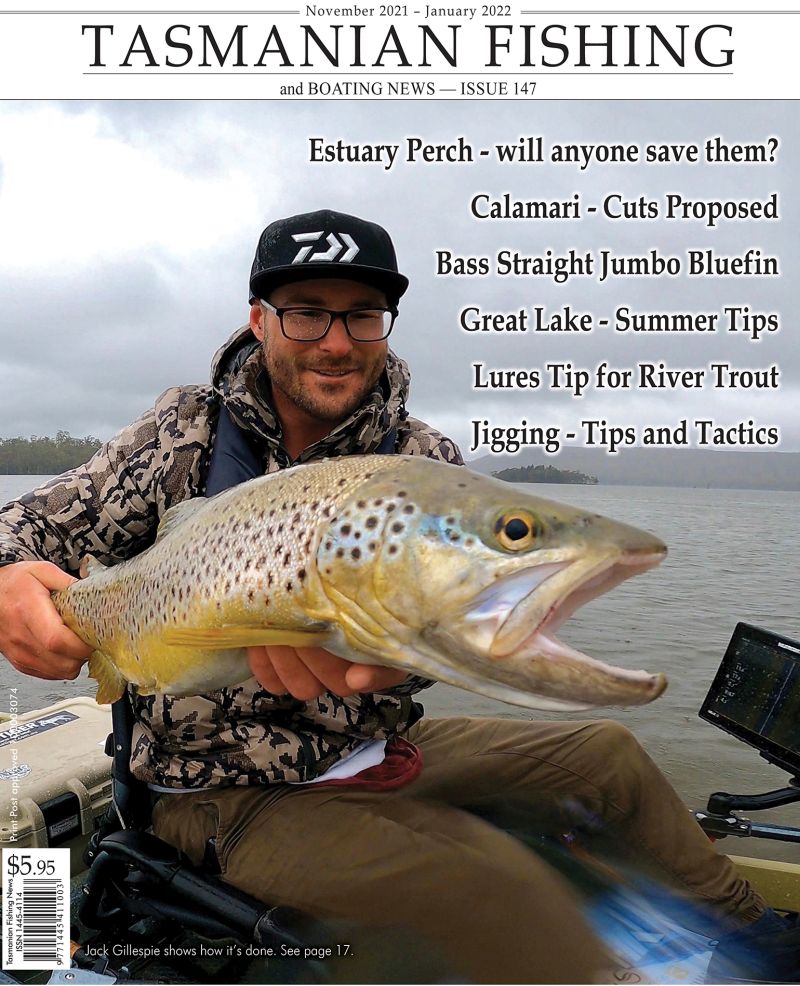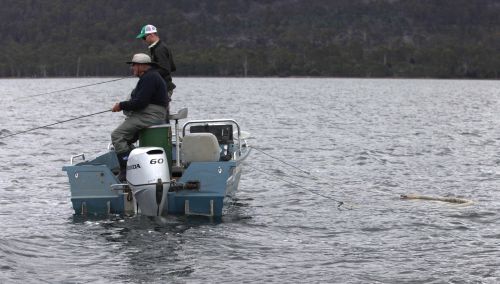Presented from Issue 95
Snap weight trolling was developed in North America for targeting suspended or structure hugging walleyes. To successfully target suspended or bottom hugging fish, no matter what species, requires a special presentation of your lure or bait. Downriggers are without doubt the best tool for precise presentations at depth, but can be a costly exercise if you are trolling in snag infested water, and you hang up your bomb on a submerged tree or rock. A snap weight line can easily be run in conjunction with a leadcore line, flat lines or downriggers. In addition, snap weight lines are perfect as planer board lines with either in line boards or double trolling boards, but let’s not worry about them here. The snap weight technique will prove a valuable asset for any dedicated troller as it will allow you to troll more deep lines without a downrigger or leadcore line. Places like Arthurs in deeper water, Great Lake, Dee Lagoon, Barrington and all the West coast waters are ideal for this technique.
At one time or another, many trollers have tried trolling sinkers of every size and description, but they all seem to have their drawbacks. If you run the weight close to the lure or bait you run the risk of spooking the fish, too far away and you can’t land the fish because the weights in the way. Enough weight to get you deep and it takes the fun out of landing the fish.
Snap weights overcome these problems because they employ a pinch pad release (like a downrigger release clip) with a trolling weight attached. The real beauty of snap weights is that they allow the angler to choose how close or how far the weight is placed from the lure.
Basically the snap weight system works by allowing the angler to determine lead, the distance the lure or bait is let out the back of the boat. Once this is established the snap weight is simply pinched open and attached to the line. The line, with weight and lure or bait attached are then let out further behind the boat, simple and very effective! Snap weights can be almost any weight you choose. Commercially they are available in sizes from ½ to 3 ounces. Because snap weights are basically a release clip with a lead weight attached by a split ring, you can experiment with a range of weights. I generally carry ¼, ?, ½, ¾ 1 ounce and 1½ ounce weights for the type of fishing I do, but I have used heavier weights as well.
They are not attached to any other line - it is just clipped on. Once you hook a fish and you are fighting the fish as you get the weight to your rod, you can unsnap the weight and play the fish unencumbered. If you choose to make up your own snap weights use a lead weight that is cylindrical or torpedo shaped to cut down on drag. Commercial snap weights are manufactured by Offshore Tackle and imported into Australia by Magnum Fishing products. Clarkson Imports also have kits available. Ask your dealer to contact them if you can’t find them. Attach your choice of weight with a large split ring to the release clip, and your ready for action.
Tackle selection:
To troll with snap weights, most trout or native tackle will fill the bill admirably. To start out with this system, I’d suggest you look for a rod with a medium to fast action in the 1.8 to 2.2 m length. Ideally you want a rod that is tippy enough to telegraph your lure’s action, but still able to cope with dragging around a bit of a weight. Your choice of reel is really a matter of personal preference. Baitcasters, overheads, or spinning reels will all do the job, though my personal preference is to use an overhead reel with a line counter.
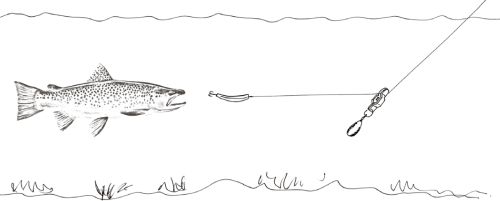
A snap weight can be clipped to the line anywhere you want. When a fish is hooked the snap weight is removed once within reach.
Line selection for snap weight trolling is fairly crucial. This technique does not require fine line diameters to help achieve depth, the weight takes care of this. Keep in mind that if you are fishing a lake with lots of snags your line is going to get a real beating. After you have landed a fish or been snagged remember to cut a metre or two off the end of your line. Most of the stretch in mono or co-polymer lines occurs near the end of the line. Cutting a bit of line off and retying your lure or bait may save you the grief of losing a good fish. Look for a tough abrasion resistant line with low stretch and something in the order of 4-5 kg breaking strain. This line is your main connection to the fish, it doesn’t pay to buy poor quality line. Over the years I’ve developed a real fondness for Platil Strong ST as a dependable trolling line. I’ve also used other brands such as Platypus and Maxima with good results.
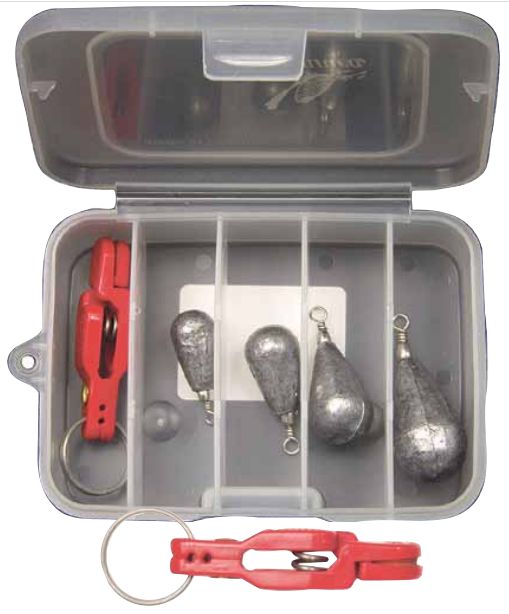
Snap Weight kit and clips are available through Clarkson Imports. Your tackle dealer will be able to order one for you.
To make your presentation as accurate as possible you need some means of measuring the line you let off your spool. For years I played with counting revolutions of the spool on my reels, measured and marked my line in an attempt to get as accurate a reading as possible of my line out. I now use a line counter reel that makes the task of measuring line out a lot simpler. They are fairly pricey. Another less expensive method of measuring line out is a clamp on line counter that fits on your rod and measures line out after it leaves the reel. I’ve toyed with a couple of these little devices and so far, the one I like best is the Australian designed Tackle Tracka. The Tackle Tracka has an LCD screen and gives you a digital rea dout of your line out. Tackle Trackas are almost impossible to find these days and you will pay about $100. Contact the Editor This email address is being protected from spambots. You need JavaScript enabled to view it. if you want one. The main purpose of all these toys is to enable the angler to accurately repeat line out. If you catch a fish at a particular depth or drop back, you can repeat the process to get back to the strike zone. If you don’t have a line counter use a permanent marker to mark your line at regular intervals. I really can’t overstress the importance of knowing how much line you have out with this technique.
To avoid constant hang- ups, you need to know where your lure is in relation to the bottom or structure. Your sounder is an indispensable tool for depicting depth and structure. Get the best you can afford and spend plenty of time learning how to use it. They are an extremely accurate piece of equipment and the detail that most modern sonar units can give you is really quite amazing!
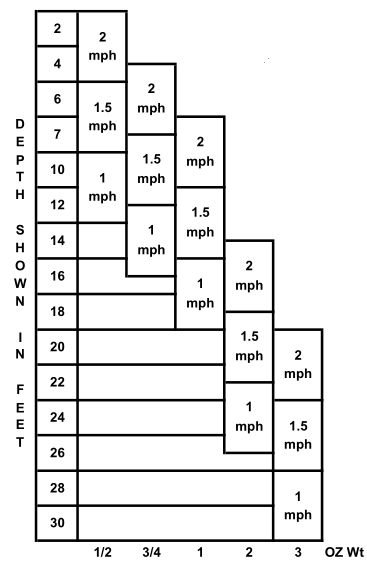
We’re very fortunate to have an enormous selection of lures to choose from. With the vast array of locally produced and imported lures, regardless of whether you are trolling for trout, Atlantic salmon or even Australian salmon, your choice is almost endless. Locally manufactured lures such as Lofty’s Cobras, Tassie Devils, Tillins King Kobras, and the local minnow style lures, as well as Rapalas or any of the plethora of soft plastics all work well with this technique. The snap weight system was developed to troll spinner baits and worm harnesses for walleye, but most minnow style lures work equally well. Just about any lure that will consistently troll on a flatline to 1 m to 1.5 m is usually a good choice. I would steer away from using this technique with deep-diving lures, trying to predict on accurate depth is just too complicated.
Don’t discount bait as an alternative with this technique. A trolled worm or even a mudeye can be deadly, especially in winter or spring when water levels are rising. Smaller attractors such as dodgers and small bladed attractors can be very productive when used in conjunction with bait, but with all but small dodgers it’s very difficult to accurately predict depth. They are not popular in Tasmania, but mainlanders really embrace them - and they work. When landing a fish you’ve hooked on a snap weight line, a steady retrieve is usually the best approach. Try to avoid the temptation of really setting the hook, you’ll find that the fish generally do a good job of hooking themselves. A heavy jerk on the line may result in your pulling the hook out of the fish’s mouth.
Boat speed and lure depth
The most widely used application for snap weight trolling is when you choose to take a normally shallow running lure to a greater depth. If you want to get the most out of this technique, remember that snap weight trolling is highly speed dependant. The slower you go, the deeper the lure will run. This also applies to the amount of weight you use, heavier weights are also going to take your lure deeper. Boat speed in the vicinity of 1.5 km/h is a good starting point. The standard trolling method with snap weights is called the 50/50 system, developed by professional walleye anglers to help standardise leads or dropbacks and to more accurately predict depth. It relies on a lead of 50 ft (15 m) being let out behind the boat, the weight snapped on and another 50 ft. (15 m) let out. The attached graphical chart is a good a starting point, and is intended as a guide to get you started. With the number of variables in this system you need to consider carefully what presentation you want. The information in the graph is accurate to within about 1-1.5 m. Your own experience will soon have you working out depths fairly close. Remember that your presentation will run slightly deeper than the snap weight.
Advanced applications
My personal favourite use for snap weights is running them off a planer board. By using snap weights on my planer board lines I can increase my coverage of fish by having a line that is not only out in undisturbed water, but down as well. This technique is often very productive if your target fish are in clear water and are spooky. To target fish that are suspended it is very handy to be able to run a couple of snap weight lines in addition to your standard flatlines.
Another application for snap weights is to use them as bottom bouncers by placing them closer to the lure. This technique is a common approach for targeting bottom hugging fish, and involves bouncing your snap weight off the bottom to attract fish to the trailing lure or bait. This is not a technique for the faint hearted, you can sacrifice a bit of gear to snags etc. but you can also catch big fish!! Don’t just think of snap weight for trout either. This will work for any species that will take a lure. Imagine a big flathead taking that bottom bounced lure.
Bill Presslor


